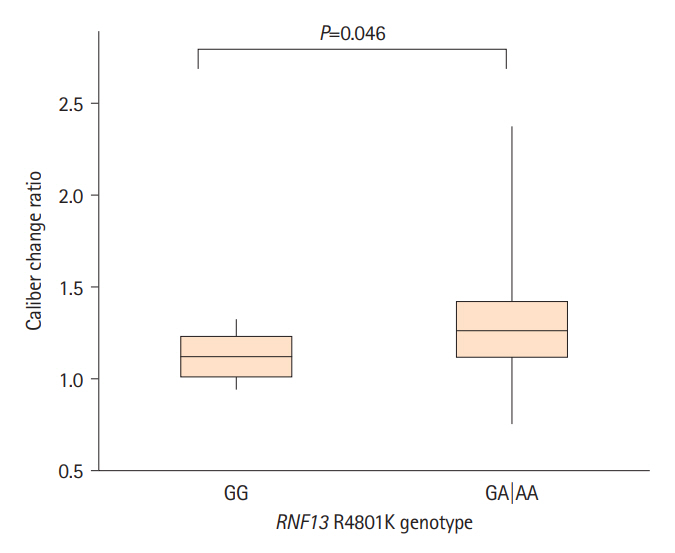J Stroke.
2023 May;25(2):303-306. 10.5853/jos.2023.00297.
Genotype–Phenotype Correlation of the RNF213 R4810K Variant in Moyamoya Disease
- Affiliations
-
- 1Department of Neurology, National Health Insurance Service Ilsan Hospital, Goyang, Korea
- 2Department of Neurology, Gangnam Severance Hospital, Yonsei University College of Medicine, Seoul, Korea
- 3Severance Institute for Vascular and Metabolic Research, Yonsei University College of Medicine, Seoul, Korea
- KMID: 2542482
- DOI: http://doi.org/10.5853/jos.2023.00297
Figure
Reference
-
References
1. Bang OY, Fujimura M, Kim SK. The pathophysiology of moyamoya disease: an update. J Stroke. 2016; 18:12–20.
Article2. Liu W, Morito D, Takashima S, Mineharu Y, Kobayashi H, Hitomi T, et al. Identification of RNF213 as a susceptibility gene for moyamoya disease and its possible role in vascular development. PLoS One. 2011; 6:e22542.3. Kim EH, Yum MS, Ra YS, Park JB, Ahn JS, Kim GH, et al. Importance of RNF213 polymorphism on clinical features and long-term outcome in moyamoya disease. J Neurosurg. 2016; 124:1221–1227.
Article4. Miyatake S, Miyake N, Touho H, Nishimura-Tadaki A, Kondo Y, Okada I, et al. Homozygous c.14576G>A variant of RNF213 predicts early-onset and severe form of moyamoya disease. Neurology. 2012; 78:803–810.
Article5. Kim JS. Moyamoya disease: epidemiology, clinical features, and diagnosis. J Stroke. 2016; 18:2–11.
Article6. Ge P, Ye X, Liu X, Deng X, Wang R, Zhang Y, et al. Association between p. R4810K variant and long-term clinical outcome in patients with moyamoya disease. Front Neurol. 2019; 10:662.7. Nomura S, Yamaguchi K, Akagawa H, Kawashima A, Moteki Y, Ishikawa T, et al. Genotype-phenotype correlation in long-term cohort of Japanese patients with moyamoya disease. Cerebrovasc Dis. 2019; 47:105–111.
Article8. Kim WH, Kim SD, Nam MH, Jung JM, Jin SW, Ha SK, et al. Posterior circulation involvement and collateral flow pattern in moyamoya disease with the RNF213 polymorphism. Childs Nerv Syst. 2019; 35:309–314.
Article9. Kawabori M, Ito M, Kazumata K, Tokairin K, Hatanaka KC, Ishikawa S, et al. Impact of RNF213 c.14576G>A variant on the development of direct and indirect revascularization in pediatric moyamoya disease. Cerebrovasc Dis. 2022; Sep. 5. [Epub]. https://doi.org/10.1159/000526089.
Article10. Wen J, Sun X, Chen H, Liu H, Lai R, Li J, et al. Mutation of rnf213a by TALEN causes abnormal angiogenesis and circulation defects in zebrafish. Brain Res. 2016; 1644:70–78.
Article
- Full Text Links
- Actions
-
Cited
- CITED
-
- Close
- Share
- Similar articles
-
- Moyamoya Disease: Cardiologist's Perspectives
- Lateral medullary infarction in a patient with Moyamoya disease associated with RNF213 variants: a case report
- Systemic vasculopathy associated with an RNF213 p.Arg4810Lys variant in moyamoya disease: A review
- Genetics and Biomarkers of Moyamoya Disease: Significance of RNF213 as a Susceptibility Gene
- Moyamoya-like Disease Associated with Intracranial Aneurysm


